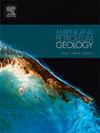Depositional and diagenetic controls on the reservoir quality of marginal marine sandstones: An example from the Early Devonian subbat member, jauf formation, northwest Saudi Arabia
IF 3.7
2区 地球科学
Q1 GEOSCIENCES, MULTIDISCIPLINARY
引用次数: 0
Abstract
The reservoir quality of marginal marine sandstones can vary significantly across different depositional lithofacies. This variation is primarily due to differences in depositional processes and subsequent diagenetic alterations occurring during various stages of burial. To address this issue, this study focuses on the Early Devonian Subbat sandstones of the Jauf Formation, which serve as an important analogue for subsurface gas reservoirs and have potential for CO2 sequestration. An integrated approach was employed, including field observations, petrography, geochemical analyses, and petrophysical analyses, to investigate the impact of depositional and diagenetic processes on reservoir quality. The findings indicate that the sandstones range from poorly to well sorted, very fine to medium-grained arkosic and quartz arenites that were deposited in a range of environments including shoreface-to-offshore transition zones, wave-dominated deltas, fluvial and tidal estuarine channels. The sandstones experienced both shallow and deep burial diagenesis, while key diagenetic events affecting reservoir quality include compaction, carbonate cementation, the formation of authigenic clays (kaolinite, illite, and chlorite), quartz overgrowth, and the dissolution of unstable feldspar and mica grains. Authigenic pore-filling cements and grain-coating clays significantly influence reservoir quality. The effect of quartz cementation was minimal where illite and/or chlorite coatings are well-developed. Mechanical compaction is more pronounced in the shoreface-to-offshore transition compared to the estuarine channels likely due to the higher detrital matrix content (21.7–35%, avg. 26.7%). The well-sorted fluvial to estuarine channel sandstones exhibit the best reservoir quality, with porosity ranging from 15.9% to 25.5% (average 20.4%) and permeability between 433.8 mD and 1261.2 mD (average 720 mD). This high reservoir quality is attributed to the low detrital matrix content (0–1%, average 0.2%) and limited pore-filling cements. In comparison, the moderately sorted, wave-dominated delta sandstones have lower porosity (5.3–11.2%, average 8.2%) and permeability (17.8–80 mD, average 42.8 mD), despite a relatively higher detrital matrix content (0–11.5%, average 2.8%). The poorly sorted shoreface-to-offshore transition sandstones exhibit the lowest reservoir quality, with porosity ranging from 1% to 2% (average 1.5%) and permeability between 0.3 and 1.1 mD (average 0.7 mD). These variations in reservoir quality among different depositional facies are primarily linked to depositional factors (sorting and detrital clay matrix) and shallow to deep burial diagenetic processes (compaction and cementation). A comprehensive understanding of these processes can enhance reservoir quality prediction in the Jauf Formation and similar reservoirs elsewhere.
边缘海相砂岩储层质量的沉积和成岩控制:沙特阿拉伯西北部早泥盆世亚巴特岩层的一个实例
在不同的沉积岩性中,边缘海相砂岩的储层质量会有很大差异。这种差异主要是由于沉积过程的不同以及随后在不同埋藏阶段发生的成岩变化造成的。为了解决这一问题,本研究重点研究了早泥盆世乔夫地层的 Subbat 砂岩,该砂岩是地下气藏的重要模拟对象,具有封存二氧化碳的潜力。研究采用了一种综合方法,包括实地观察、岩石学、地球化学分析和岩石物理分析,以研究沉积和成岩过程对储层质量的影响。研究结果表明,这些砂岩从分选较差到分选良好,从非常细粒到中等粒度的安山岩和石英安山岩,沉积在一系列环境中,包括从海岸到近海的过渡带、以波浪为主的三角洲、河流和潮汐河口水道。砂岩经历了浅埋和深埋成因过程,而影响储层质量的主要成因事件包括压实、碳酸盐胶结、自生粘土(高岭石、伊利石和绿泥石)的形成、石英过度生长以及不稳定长石和云母颗粒的溶解。自生孔隙填充胶结物和晶粒包覆粘土对储层质量有重大影响。在伊利石和/或绿泥石包裹层发达的地方,石英胶结的影响很小。与河口水道相比,从海岸面到近海过渡段的机械压实更为明显,这可能是由于其脱泥基质含量较高(21.7%-35%,平均 26.7%)。分选良好的河口至河口河道砂岩显示出最佳的储层质量,孔隙度在 15.9% 至 25.5% 之间(平均为 20.4%),渗透率在 433.8 mD 至 1261.2 mD 之间(平均为 720 mD)。这种高储层质量得益于较低的碎屑基质含量(0-1%,平均 0.2%)和有限的孔隙填充胶结物。相比之下,中度分选、以波浪为主的三角洲砂岩,尽管脱盐基质含量相对较高(0-11.5%,平均 2.8%),但孔隙度(5.3-11.2%,平均 8.2%)和渗透率(17.8-80 mD,平均 42.8 mD)都较低。分选较差的岸滩到近海过渡砂岩的储层质量最低,孔隙度在 1%到 2%之间(平均 1.5%),渗透率在 0.3 到 1.1 mD 之间(平均 0.7 mD)。不同沉积面之间储层质量的这些变化主要与沉积因素(分选和碎屑粘土基质)以及从浅埋到深埋的成岩过程(压实和胶结)有关。对这些过程的全面了解可以提高对焦夫地层及其他类似储层的储层质量预测。
本文章由计算机程序翻译,如有差异,请以英文原文为准。
求助全文
约1分钟内获得全文
求助全文
来源期刊

Marine and Petroleum Geology
地学-地球科学综合
CiteScore
8.80
自引率
14.30%
发文量
475
审稿时长
63 days
期刊介绍:
Marine and Petroleum Geology is the pre-eminent international forum for the exchange of multidisciplinary concepts, interpretations and techniques for all concerned with marine and petroleum geology in industry, government and academia. Rapid bimonthly publication allows early communications of papers or short communications to the geoscience community.
Marine and Petroleum Geology is essential reading for geologists, geophysicists and explorationists in industry, government and academia working in the following areas: marine geology; basin analysis and evaluation; organic geochemistry; reserve/resource estimation; seismic stratigraphy; thermal models of basic evolution; sedimentary geology; continental margins; geophysical interpretation; structural geology/tectonics; formation evaluation techniques; well logging.
 求助内容:
求助内容: 应助结果提醒方式:
应助结果提醒方式:


